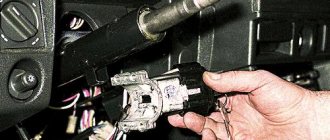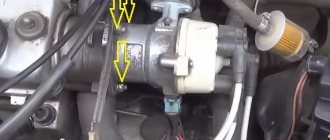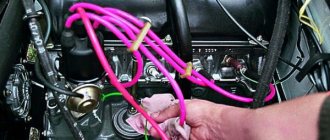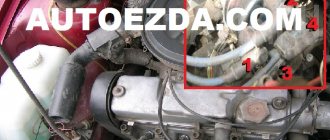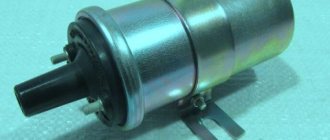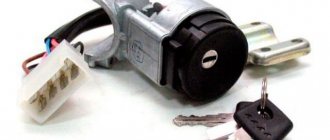Author: Evgeny Zhivoglyadov. Publication date: December 18, 2022. Category: Automotive equipment.
In order for a gasoline engine to work, the fuel must ignite in its cylinders. It is truth. Therefore, the ignition system (at first, naturally, contact) appeared simultaneously with the car. But progress does not stand still. He, of course, also affected the ignition system: the traditional method of generating a spark was replaced by a more efficient and reliable one, namely, non-contact. This will be discussed in this article.
The main differences between traditional and contactless ignition systems
When a gasoline engine is running, sparking (that is, the supply of high voltage to the spark plug) occurs at the moment when the low-voltage power circuit of the ignition coil is opened. In a traditional system, such a “switch” is the contacts of a mechanical breaker, which periodically open when they come into contact with the cams of the rotating rotor of the distributor.
It was this unit that was replaced during the transition to a contactless system. The control signal in it is generated by a special sensor (inductive, optical or Hall sensor) installed under the distributor cover. An electrical impulse is sent to a semiconductor switch, which controls the primary winding of the ignition coil.
On a note! It is still impossible to fully call the ignition system of most modern cars (mid-price category) contactless. The fact is that the contacts installed in the distributor cap still participate in the sparking process, because it is through them and the slider that high voltage is supplied to the spark plugs.
What does the BSZ consist of?
Contactless ignition includes a small number of parts, thereby reducing the likelihood of failure of each of them. The system consists of:
- Power supply. In all cars it is the battery.
- Ignition and starter switch. The part is necessary for the correct distribution of operating time of the device.
- Ignition coil. Converts low-voltage current from the battery into high-voltage, which ensures stable operation of the car.
- Transistor switch. Responsible for interrupting the flow of electrical current to the coil.
- Ignition sensor. Detects changes in the magnetic field.
- Distribution sensor. The sensor is combined with a pulse sensor, which comes in several types. The pulse sensor is most often represented by a Hall sensor, but there are also two more varieties - inductive and optical.
- Candles.
Advantages and disadvantages of a contactless ignition system
Despite the fact that the contactless ignition system (BSI) is more expensive (this is perhaps its only drawback) compared to the traditional one, it is now used in all modern cars. Better sparking in BSZ is due to the fact that due to the use of a semiconductor switch, energy losses on the primary winding of the coil are reduced, and this, in turn, leads to an increase in voltage on the secondary. As a result, more complete combustion of the fuel-air mixture occurs in the engine cylinders. Hence all the ensuing advantages of a contactless ignition system:
- increase in engine power;
- fuel economy;
- improving the dynamic characteristics of the car;
- reduction of exhaust gas toxicity;
- confident engine starting in conditions of high humidity and high negative temperatures;
- stable engine operation at various speeds (up to maximum);
- increasing the service life of spark plugs.
Benefits of the contactless circuit
How is a contactless ignition system useful, besides, in fact, the absence of those same ill-fated contacts?
It turns out that its use helps increase the power of power units, reduces the amount of harmful emissions into the atmosphere and even reduces fuel consumption.
All this, as experts say, became possible thanks to a higher spark generation voltage than in older systems, which reaches 30,000 Volts.
These goodies, by the way, encourage some drivers to change old contact circuits to contactless ones. Moreover, this is quite simple to do and many car owners do this kind of minor tuning on their own.
Dear readers, as we can see, the non-contact ignition system, the operating principle of which we tried to study today, has become the next step towards circuits of a qualitatively new level, with more reliable and durable components.
Methods for converting a contact ignition system into a contactless one
Naturally, a huge number of cars (both imported and domestic) equipped with a standard ignition system travel along the roads of our vast Motherland. Increasing the efficiency and reliability of its operation is the dream of any vehicle owner. Nowadays, doing it yourself is quite easy. There are two main ways (we do not consider the option of a completely homemade device) to modernize the ignition system:
- Purchase and installation of a complete set of contactless ignition. Although this tuning option is quite expensive, experts consider it the most “correct” from a technical point of view. Only by completely replacing the standard ignition system can you get a new one that has all the advantages of contactless sparking.
- Modification of the “native” distributor by installing a special module, which is a small-sized “3 in 1” device (sensor, signal amplifier and switching transistor). This modernization option is less expensive and allows you to slightly improve the technical characteristics of the traditional ignition system by eliminating the “problematic” mechanical breaker from the circuit.
On a note! Manufacturers of automobile parts offer users kits that allow them to modify ignition systems for various vehicle models, in accordance with the options described above.
Design and operating principle of BSZ
So which ignition is better? Before we talk about installing and adjusting electronic ignition with our own hands, let's look at the operating principle of the BSZ and its design. So, the contactless ignition system is a rather complex device in design, which consists of many parts.
Among the main components it is worth highlighting:
- coil;
- vacuum and centrifugal voltage regulators;
- switching device;
- signal controller;
- high voltage wires;
- candles;
- accumulator battery.
These are the main elements that include the contactless ignition kit. As for the principle of operation, it is quite simple. When the driver turns the key in the lock, voltage begins to flow to the mounting block and here it is distributed between the starter, coil and other consumers of the car's current. The crankshaft begins to move, causing the signal controller to begin transmitting pulses to the switching node. The purpose of the latter is to stop the supply of voltage to the coil windings, due to which a higher voltage current is generated in the secondary turns.
BSZ diagram with designation of elements
This current makes it possible to generate a strong spark at the candles, which is subsequently used to ignite the combustible mixture. Current flows to the spark plugs in a certain order, in accordance with the position of the crankshaft. This process is carried out under the control of regulators, which can determine not only the frequency with which the shaft moves, but also the degree of load on the power unit. If the non-contact ignition system is adjusted properly, a high-power spark plug will form on the spark plugs, which will ensure normal ignition and combustion of the combustible mixture.
A budget option for switching to a contactless system
The contacts of the mechanical breaker “burn out” and wear out, so they have to be periodically cleaned and the gap adjusted. Installing the Sonar IR module (costing 700÷900 rubles) in the distributor allows owners of classic VAZs (2101-2107) to be spared from this routine work.
The device consists of:
- optical sensor (infrared radiation source and photodetector);
- electrical signal amplifier;
- switching transistor.
Important! All of the above is mounted in a miniature waterproof housing, which makes it quite easy to install it in place of a standard contact breaker.
The operating principle of the module is as follows:
- When the distributor rotor rotates, its cams periodically block the light flux of the optical sensor.
- Electrical impulses from the photodetector are amplified by a built-in microcircuit and supplied to a control transistor, which opens/closes the circuit of the primary winding of the coil.
On a note! LED indicators (red and green) inform about the state of the electronic switching key (closed/open).
How to install and configure Sonar IR is described in detail in the video below:
Advantages of BSZ over KSZ
While writing the article, I sat and thought and thought, and still did not come to the conclusion of what exactly is the main advantage of BSZ; for me, all the advantages listed below are the main ones and are equal to each other.
So let's get started:
— High stability of engine operation (synchronous operation of the cylinders, strictly in turn)
— Frisky review of the throttle
— Better engine thrust (which allows you to easily use the largest drive stars without difficult acceleration!)
— Candles “live” four times longer than on KSZ (I’ll write about this separately below)
— Less well-known “snot” from Java mufflers (since fuel and oil are burned much better)
— Longer service life of all crank bearings (as there is less extraneous detonation and vibration)
— Less fuel consumption (since it burns better, the carburetor must be adjusted to a lower fuel supply)
Contactless sensor-breaker for foreign cars
Owners of foreign cars can purchase a simple device from UltraSpark, Pertronix or AccuSpark, which allows them to quickly “convert” a standard ignition system into a contactless one. The delivery package for this device includes:
- Induction sensor-interrupter.
- A plastic trigger ring with neodymium magnets pressed into it (according to the number of engine cylinders).
- Installation instructions and connection diagram.
According to manufacturers, installation of a non-contact sensor-interrupter (BSD) takes no more than 30 minutes:
- Remove the distributor cover and slider.
- We dismantle the contact group of the mechanical breaker and the spark-extinguishing capacitor.
- We install the BDP and bring its wires out through the hole in the housing.
- We put a trigger ring on the rotor axis.
- We return the slider and distributor cover to their place.
- We connect the wires from the installed sensor to the ignition coil in accordance with the diagram.
Important! Knowing the distributor model, you can select a contactless breaker module for almost any brand of foreign-made vehicle.
The undoubted advantages of the BDP are:
- Low cost.
- Easy to install.
- Possibility of use with stock distributors and high-voltage coils of a specific car brand.
Contact angle correction in closed state
Adjusting the ignition of the VAZ 2106 begins with the simplest operation of removing the distributor cover, then turning the crankshaft until the maximum distance between it and the distributor is reached. After this, they begin to unscrew the screws that fix the contact group on the bearing plate and between the contacts, and insert a probe to determine and select the optimal position for the group. Ideally, everything is determined by the force applied to move the probe, which should be minimal; having found an area that meets this requirement, the position of the group is fixed by tightening the screws. The size of the gap also matters; to determine it, the thickness of the feeler gauge should be 0.44 millimeters. It is the adjustment of the gap that provides the required value of the angle of closed contacts; its optimal value is 55±3°.
If the parameters correspond to the norm, then you can proceed to the second stage, which consists in adjusting the advanced ignition angle. To begin with, let us determine that the distributor chopper in the type of engine under consideration needs to realize the opening moment simultaneously with the spark in the first cylinder. This provides for an advance of the top dead center of the piston stroke for the first cylinder by 0±1°.
Lead angle correction using a strobe light
There are several ways to adjust this indicator, on which the correct ignition adjustment of the VAZ 2106 as a whole largely depends. The most efficient way to cope with this task is to use a strobe light. The device must be connected to the vehicle electrical network, and the vacuum correction hose must be removed and plugged from the distributor. Following this, the engine is warmed up until it maintains idle speed, followed by loosening the bolt responsible for fixing the distributor housing.
The light emitted by the strobe is directed to the crankshaft pulley; rotating the distributor body will allow you to achieve a position that ensures that the visible position of the mark on the pulley is opposite the corresponding marks marked on the timing cover. In this position, the distributor body is fixed by tightening it with bolts. The presence of idle speed of the power unit during the adjustment process is of decisive importance. If the speed is higher, the centrifugal regulator will take part in the work, which will distort the adjustment results.
Complete non-contact ignition system
Naturally, you won’t be able to get all the benefits of the BSZ by installing only a sensor-interrupter. This module only improves the reliability of sparking (without skipping) and relieves owners from the need to constantly monitor the condition of the mechanical contact group. In order to equip your car with a full-fledged BSZ, you need to purchase a kit consisting of:
- distributor, with installed Hall sensor;
- semiconductor switch;
- high voltage coil;
- connecting wires with installed blocks.
Such a set for classic VAZ cars from SOATE (Russia, Stary Oskol) currently costs about 2,500 rubles. The video below describes in detail the process of installing it yourself:
Instructions for installing a homemade BSZ
If you have decided which ignition is better, then let’s move on to the issue of installing a better option on your car. Installation of contactless ignition begins with the installation of a block equipped with a steel plate with mounting holes, which is necessary for cooling. Let's look at the procedure using the example of a classic VAZ 2107 car. There should be holes on the left side member to which the switch is screwed using two self-tapping screws. If there is no hole, then find a place next to the coil and drill holes there (the author of the video is the Sdelaj Sam channel! Pljus interesnoe!).
When installing a homemade electronic ignition, the switch cannot be mounted next to the washer reservoir. After all, if it leaks, then all the electronics will be “covered.” Before dismantling high-voltage wires, remember their location.
Installation of BSZ is carried out in the following order:
- First, you need to remove the cover from the new distributor and install the gasket. The distributor is mounted on the block so that its moving contact is located opposite the mark on the valve cover of the power unit. The so-called distributor skirt should be slightly pressed using a fastening nut, this will prevent possible rotation of the distributor.
- Next, you need to install the coil at the installation site. After this, you should connect the wires from the lock relay, switch, and tachometer to its terminals. The wire that comes from pin 1 on the block must be connected to terminal K directly on the coil. As for the wire from pin number 4, it is connected to terminal B.
- After performing these steps, you need to set the gap on the electrodes of the spark plugs to about 0.8-0.9 mm, and then the spark plugs themselves can be screwed into the seats. Place the cover on the distribution unit and connect all the necessary wires in the appropriate order. Then all you have to do is connect the vacuum line. Having done this, you can begin adjusting the unit.
1. Disconnect the wires from the distributor.
2. Remove the distributor.
3. Install the switch.
Ignition system without distributor
The most “advanced” and truly contactless is the electronic ignition system, which does not have a mechanical distributor, since its functions are performed by the on-board computer. It “determines” the moment of spark formation in the corresponding cylinder based on signals received from the camshaft and crankshaft position sensors. Instead of one high-voltage coil, the system uses several (one for each engine cylinder). This allows you to create a more powerful spark, since the computer, depending on the engine speed, clearly “determines” the time required to accumulate energy.
On a note! Even more innovative is the ignition system, in which the coils are mounted directly into caps placed on the spark plugs. This allows you to get rid of high-voltage wires, which in turn reduces electricity losses, and also increases the reliability and efficiency of the sparking process.
Magneto
One of the first ignition systems is a magneto. It consists of a current generator that creates a discharge solely for sparking. The system consists of a permanent magnet, which is driven by the crankshaft and an inductor. A spark capable of breaking through the spark gap is generated by a step-up transformer, one part of which is the rough winding of the inductor. To increase the voltage, a part of the generator winding is used, which is connected to the spark plug electrode.
Magneto ignition system
Control over the supply of a spark can be contact, made in the form of a breaker, or non-contact. With the non-contact spark supply method, capacitors are used to improve the quality of the spark. Unlike the ignition circuits presented below, a magneto does not require a battery, it is lightweight and is actively used in compact equipment - brush cutters, chainsaws, generators, etc.


